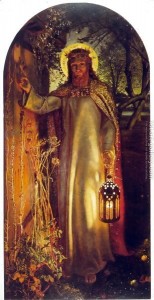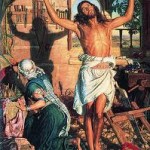Next FREE tour, The Great Art Treasures of Manchester: Tue 4 June 2024.
Meet: outside St Ann’s Church. St Ann Street, 11.15 a.m.
Booking: Please press here to book with Eventbrite.
Thoroughly-detailed and wonderfully enlightening tours of Manchester’s greatest art treasures, from the baldacchino in the Central Library Reading Room and the reasons for its existence, which include the most wonderful links with Rome, a trip to see The Stations of the Cross in the Church of the Hidden Gem, and then into Manchester Art Gallery to see works by Turner, Lorrain, Bacon, Watts, Stubbs and of course the Pre-Raphaelites.
These are the kinds of guided tours that you never thought possible. Copious research has unearthed the most remarkable stories and links thanks to our guides’ determination to explain everything, alongside a deep-rooted fascination for all those strange religious connections.
Here’s an example with The Light of the World, by William Homan Hunt (1851-56). This picture not only hangs in Manchester Art Gallery but it also at Keble College Oxford and St Paul’s Cathedral. So which is the real one or all three equally authentic? The St Paul’s canvas was painted nearly fifty years later, with the assistance of Edward Robert Hughes. The Manchester version might be by his pupil Fred Stephens.
 In the painting Christ is knocking at the door, i.e. the human soul, an idea taken from Revelation 3:20.
In the painting Christ is knocking at the door, i.e. the human soul, an idea taken from Revelation 3:20.
“Behold I stand at the door and knock. If any man hear My voice, and open the door, I will come in to him, and will sup with him, and he with Me.”
The door has no handle so can only be opened from the inside – by the individual letting Christ in. His lantern is bringing light into the world. The title comes from John 8: 12.
“Again Jesus spoke to them, saying, ‘I am the light of the world. Whoever follows me will not walk in darkness, but will have the light of life.’”
Hunt painted by moonlight to get the right effect. He wanted it to look supernatural. The face is Christina Rossetti’s. The robe an old tablecloth. The lantern was made to his design and is on display in Manchester Art Gallery near the painting. The hair is that of Lizzie Siddall, doomed wife of his Pre-Raphaelite partner Dante Gabriel Rossetti in whose hair a book of poems written by Rossetti became intertwined after he had buried the work in her coffin, as he discovered when he was allowed to open the grave to retrieve the writings. The setting is a friend’s house in Homerton although the painting was executed in the orchard of Worcester Park Farm, Surrey, in December 1851.
Fifty years after painting Hunt explained:
“I painted the picture with what I thought, unworthy though I was, to be by Divine command, and not simply as a good Subject. The door in the painting has no handle, and can therefore be opened only from the inside, representing the obstinately shut mind. In making it a night scene, lit mainly by the lantern carried by Christ, I had followed metaphorical explanation in Psalms: ‘Thy word is a lamp unto my feet, and a light unto my path.’
According to the 19th century’s main art critic, John Ruskin, the picture was “the most perfect instance of expressional purpose with technical power which the world has yet produced.”
Van Gogh regarded it as the supreme depiction of Christ.


